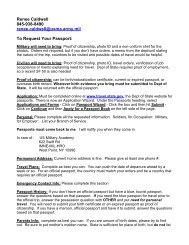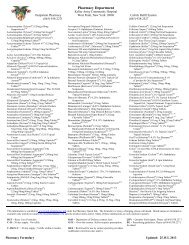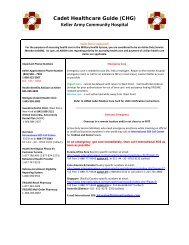in the HMMWV after we were hit in a state of shock. As I triedto figure out what had just happened I examined my injuries.Fingers on my gloved right hand were dangling off and I assumedthat they would be lost. My left hand was locked back from thetendons that were cut by the piece of shrapnel embedded in mywrist. At first, I did not even realize I had broken my leg, until Itried to move and felt the intense pain. The buttstock of my M4,broken from the shrapnel passing through the vehicle floppedover my right. I knew I was going to be out of the fight. I canremember looking at the gunner lying next to me in a heap on theHMMWV floor. He was conscious, but it was hard to tell exactlywhat his injuries were. He had been knocked out of his hatch andlost both his legs below the knee. The driver was able to get out ofthe HMMWV and open my door in spite of his own serious leginjury. As I sat in the HMMWV, stuck because of my broken legand tangled metal at my feet, I thought “God, I hope to get homeand see my family again”. As ridiculous as it may sound, my nextthought was “I hope I will be able to ride a bicycle again”.I was evacced to Landstuhl. One of my doctors there asked whatmy recovery goals were, which forced me to think about where Ireally wanted to go as I fought to recover and rehabilitate. It didn’ttake me long: I wanted to stay in the <strong>Army</strong>, I wanted to ride a bicycleagain, and I wanted to ride my motorcycle again. As improbableas those goals may have appeared, he made no judgment onthem. Returning to cycling became my focal point that was goingto enable me to achieve my other big goal of staying in the <strong>Army</strong>.Lt. Col. David Haines, WTB Commander, Ireland <strong>Army</strong> <strong>Community</strong> <strong>Hospital</strong>,Fort Knox, Ky., rides through rough terrain during the La Ruta delos Conquistadores mountain bike race in Costa Rica.La Ruta de los Conquistadores. I don’t remember how I first heardof this race, whether it was a magazine article or it seeped into myconsciousness over time. I have always known its reputation as thetoughest mountain bike race in the world. Before I was wounded,La Ruta was always one of those events that I thought would begreat to do, but I never took a serious interest in the steps to do it.I was perfectly happy riding my local trails, riding my road bikewith friends, and racing on the weekends. I was passionate aboutcycling before my injuries.In October 2006, I was seriously wounded by an ExplosivelyFormed Projectile (EFP) IED while on a mounted patrol in Baghdad,Iraq. I took shrapnel injuries to my right side, right leg, righthand and arm and my left arm. The worst injuries were shatteredbones in my right hand, segmented ulnar nerve and ulna bone inmy left arm, and a non-union fracture to my right femur. Evenwith all that I consider myself lucky. My counterpart, Maj. DavidTaylor, was killed and the rest of the crew lost limbs in the IEDstrike. I was conscious the entire time. I can remember sitting24Today, after years of hard fought recovery, about 30 surgeries, fourdifferent attempts to repair my fractured leg, the last one successful,I have attained two of my three goals. I was found fit to returnto duty, and I am finishing 2011 having completed over 6,000miles of cycling. Cycling has allowed me to get in better conditionthan when I was five years younger; represent the <strong>Army</strong> at the2011 Warrior Games, winning a silver medal; ride with PresidentBush and Lance Armstrong; ride from Ground Zero in New YorkCity to Shanksville, Pa. and the Pentagon over eight days on thetenth anniversary of those horrible attacks; and complete thetoughest mountain bike race in the world as a 46-year-old woundedwarrior.My road to La Ruta started this way. During my recovery, I hadtried to mountain bike, but had a number of serious crashes due tomy injuries. I do not have full mobility or function in either of myhands, so it was difficult for me to hold on to the handlebars. So,I focused on riding my road bike. Over time I slowly got stronger.I was offered the opportunity by the nonprofit Ride2Recovery toparticipate with 13 other wounded warriors in a mountain bikeride, the W100, with President George Bush at Big Bend NationalPark. I had not ridden a mountain bike in over a year, but theopportunity to ride with President Bush was enough motivationto get me back on the trails. After all, how hard could it be? It’s inthe middle of the Texas desert, which I mistakenly assumed wasflat, and it would be led by a 64 year-old man. It was not easy. Thearea around Big Bend is rugged and beautiful. President Bush is amonster on a mountain bike. I survived with only one good crashto my credit. This ride also linked me up with a number of inspirationalfellow wounded warriors. I had known Marc Hoffmeistersince 2005 when we both attended CGSC/ILE at Fort Leaven-
worth, Kan. I knew he was an accomplished adventure sportathlete participating in everything from Eco-Challenges to seriousmountain climbing.The experience with President Bush boosted my confidence.The other wounded warriors I met inspired me to push myself alittle further. I started thinking about taking on La Ruta. At firstI thought about just doing it myself, but I figured I should fullycommit and get other people involved. Pride would prevent mefrom talking myself out of it.As I sat in theHMMWV, stuckbecause of mybroken leg andtangled metalat my feet, Ithought “God,I hope to gethome and seemy family again”.As ridiculous asit may sound, mynext thought was“I hope I willbe able to ride abicycle again.”-Lt. Col. David HainesI knew that the train-upwould be demanding. Therace is 240 miles and climbsover 40,000 feet in justfour days across the entirecountry of Costa Rica. Theclimate and terrain rangesfrom sea level, hot andhumid, to 10,000 feet, cooland rainy. I had no illusionsabout keeping up with theprofessional mountain bikerscontending for podiumspots. My goal was simplyto finish, which would putme in pretty elite company.In 19 years, less than 6,000people have finished therace successfully. By the endof my training, I was riding80-100 mile rides on mymountain bike and climbing5,000 feet of elevation inone day.Marc and I travelled toCosta Rica a few days aheadof time to get a feel for theweather and the terrain.One thing became clearfrom the begining - CostaRica is a truly beautfulcountry with friendlypeople.DAY ONE. I woke up early and mistook the pounding of the surf asthunder. Nerves prevented me from eating as good a breakfast as Ishould have. By the time I came to the starting line it seemed as ifeveryone was already going through their pre-ride rituals. I spentmost of my time riding around to loosen up my legs.As the race started, my advice to myself to go easily was quicklydisregarded as the mountain bike peloton sped into the foothillsof the mountains. As the ride went on, the trail narrowed andbecame steeper, gravel giving away to dirt, that gave away to mudand stream crossings and hike-a-bike sections climbing steepmuddy slopes and jumping over deep ravines washed out by thewater running down hill. My heart rate was running in the 160’sand 170’s and I knew I would not be able to maintain this for longbut did not listen to my body. Marc was having a little easier timeof it. His experience as an adventure racer and mountain climberwas showing as he led me through the tougher climbs and sectionswhere we had to carry our bikes. I was overheated and exhaustedwithin the first 20 miles, and still had another 50 or so to go. Istopped in streams to cool my body and slow my heart rate. Iwasn’t going to quit; it was way too early.At the first checkpoint I caught up with Marc and tried to eat andrehydrate, but I had already put my body in a serious deficit. Therest of the day was a struggle just to keep going. Marc waited forme at checkpoints. He was determined not to let his battle buddyfail. At the last check point of the day the close out time at the finishline was looming, so I told Marc to go so he could make cutoffand remain an official competitor. I would drag myself in. I continuedto ride in misery. As I closed in on San Jose the roads becamepaved, but the hills were still long and steep. At points I had to getoff my bike and walk the hills because I had no power left in mybody to pedal. I reached the outskirts of San Jose as it was gettingdark. I only had a few miles to go and knew that making cutofffor the first day was going to be close. As I rode through the city Imustered all my strength to finish as quickly as I could.I rolled into the finish line and was relieved that the day wasfinally over. I thought I had come up short on the cutoff time andwould no longer be an official competitor, which meant I wouldbe allowed to start the next day, but would be classified as a DNF(did not finish) at the end of the race. I was disappointed, butafter the pain of the first day, doubted I would be able to carry onfor another three days like this. As I sat at the finish line totallyexhausted and oblivious to everything going on around me, one ofthe race organizers came up and said “Congratulations! You madecutoff by four minutes”. I honestly had mixed feelings. I just didn’tknow if I would be able to get up the next day and do this to myselfall over again.DAY TWO. I woke up and went to breakfast with Marc. I was stilldealing with the toll inflicted on my body from the first day. It washard to eat breakfast; my system was disrupted from the previousday’s effort. Marc was doing better. Today was another tough dayon the bike. He sensed the difficulty I was having and his encouragementconvinced me to get on the bike and start the race. I hadserious doubts in myself. Getting outside and feeling the freshair improved my mood. My strategy for day two was simply tosurvive. The race started and I rolled out, ready for the hills thatwould hit us within the first few miles. I worked on keeping mybreathing controlled and was able to engage in conversation withother riders as we slowly climbed the steep hills. As I reached thefirst big peak of the day, I fought to stay on my bike and not walk.At one point the hill became too steep. I unclipped from my pedals.The sudden loss of momentum and the steepness of the hillmade me lose my balance as I straddled my bike. I started to hopon my left foot to maintain my balance. I was able to get my rightleg off my bike as I hopped, but as I did, my left foot hit the edge ofa concrete culvert on the side of the road. My feet went out fromunder me and I did a belly flop in the culvert and slid down hill25





